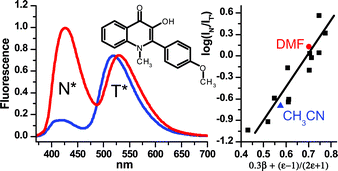Modulation of dual fluorescence in a 3-hydroxyquinolone dye by perturbation of its intramolecular proton transfer with solvent polarity and basicity
Abstract
A representative of a new class of

* Corresponding authors
a Department of Chemistry, Kyiv National Taras Shevchenko University, Kyiv, Ukraine
b Photophysique des Interactions Biomoléculaires, UMR 7175 du CNRS, Institut Gilbert Laustriat, Faculté de Pharmacie, Université Louis Pasteur, Illkirch, France
A representative of a new class of

 Please wait while we load your content...
Something went wrong. Try again?
Please wait while we load your content...
Something went wrong. Try again?
D. A. Yushchenko, V. V. Shvadchak, M. D. Bilokin', A. S. Klymchenko, G. Duportail, Y. Mély and V. G. Pivovarenko, Photochem. Photobiol. Sci., 2006, 5, 1038 DOI: 10.1039/B610054F
To request permission to reproduce material from this article, please go to the Copyright Clearance Center request page.
If you are an author contributing to an RSC publication, you do not need to request permission provided correct acknowledgement is given.
If you are the author of this article, you do not need to request permission to reproduce figures and diagrams provided correct acknowledgement is given. If you want to reproduce the whole article in a third-party publication (excluding your thesis/dissertation for which permission is not required) please go to the Copyright Clearance Center request page.
Read more about how to correctly acknowledge RSC content.
 Fetching data from CrossRef.
Fetching data from CrossRef.
This may take some time to load.
Loading related content
